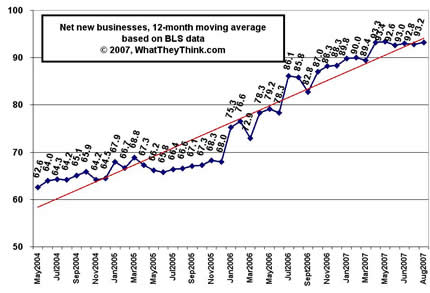Today's unemployment report was stunning to say the least, but that's not in the papers or the news. Because it was good news, it was glossed over very quickly. Some stories focused on the 4.7% unemployment rate, up from last month's 4.6%.
Last month, August payroll employment was down -4,000, and the sky was falling (as we wrote the other day, it's not falling, it's just a little loose). In today's report, August was revised to +89,000, meaning that they had “missed” 93,000 jobs last month.
Most people, and perhaps most reporters, don't realize that the error range for the household survey is about +/- 100,000. That sounds like a lot. But it's only +/- 0.065% of the workforce. We have a huge workforce, and 100,000 people, though it could fill two baseball stadiums, is almost negligible in comparison.
All that said, September's payrolls increased by +110,000. That's not the real story, however. The unemployment rate is calculated based on the household survey, and that's where the action is.
The household survey is what is used to report the unemployment rate. It's a ratio of people who can't find work divided by the number of everyone working and everyone looking for work.
In September, 463,000 more people found work than in August. A surprising number of people, 573,000 entered the workforce. The bulk of them did find work, obviously, but many did not. Why was there a rush of people into the workforce? There's good reason to believe it's related to the fact that many adjustable mortgages are now coming to their adjustment cycle, and that households need more money to pay those bills.
Remember, you're not counted as unemployed unless you are looking for work. If a household member decides to look for work, they are immediately added to the unemployed. This is one reason why the unemployment rate keeps going up after the peak of a recession. As business improves, discouraged workers re-enter the workforce, increasing the denominator of the unemployment calculation.
The bottom line numbers are that we set new records for non-farm employment at 138.2 million people, total employment of 146.2 million people, and a total workforce of 153.5 million people. Never in the history of the U.S. has the workforce been this big, and this employed. It's not likely you'll be reading that in this weekend's newspapers.
But wait, there's more!
Even more interesting is that the number of net new businesses, which we track as a 12-month moving average, is now 93,200 net new businesses per month. There, 12,000 new construction businesses were formed in September, compared to only 9,000 last September. Construction workers are obviously leaving payroll employment as housing contracts, but still working as freelancers. It's good to know that there is still a sense that when people lose their jobs, the majority still tend to look for work, even if it is an accidental and unwanted entrepreneurship. It also means that there is still construction work to be found, though prices may not be what they were getting as little as a year ago.
The sky's not falling, and it's less loose than we thought the other day.

View larger chart














